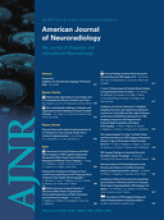Abstract
BACKGROUND AND PURPOSE: The aim of our study was to assess the accuracy of multidetector row CT angiography (MDCTA) in the detection of the underlying vascular abnormalities causing spontaneous lobar intracerebral hemorrhage (ICH) compared with conventional digital subtraction angiography (DSA).
MATERIALS AND METHODS: Seventy-eight patients who underwent MDCTA with use of a 16-detector row scanner and DSA were prospectively included in this study. Each study was assessed by 2 independent blinded neuroradiologists; decisions were made in consensus. Findings on CT angiograms, including the original axial data, multiplanar reformations, and volume-rendered images with and without automated bone segmentation, were used to identify the underlying causes of ICH.
RESULTS: Twenty-two of the 78 patients (28.2%) exhibited angiographic abnormalities, including aneurysms of the proximal arteries (n = 9), arteriovenous malformations (n = 7), Moyamoya disease (n = 4), and aneurysms of the distal arteries (n = 2). MDCTA detected the underlying vascular abnormalities in 21 patients except 1 case of small arteriovenous malformation. Overall sensitivity, specificity, positive predictive value, negative predictive value, and accuracy of MDCTA for detection of underlying vascular abnormalities were 95.5%, 100%, 100%, 98.2%, and 98.7%, respectively.
CONCLUSIONS: MDCTA is a highly accurate imaging technique in the diagnosis of underlying vascular abnormalities in patients with spontaneous lobar ICH.
- Copyright © American Society of Neuroradiology












